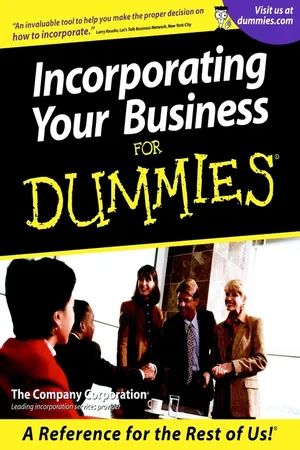
Incorporating Your Business For Dummies
- English
- ePUB (mobile friendly)
- Available on iOS & Android
Incorporating Your Business For Dummies
About This Book
If you're a business owner, incorporation can help you protect your personal assets and cut down your tax bill. But all the paperwork and legalese can make incorporation seem like more trouble than it's worth. Incorporating Your Business For Dummies offers all the savvy tips you need to get incorporated — starting today!
Whether your business is big or small, incorporating isn't as simple as it could be. This handy reference makes incorporation make sense, and guides you through the process step by step. From handling the mountain of paperwork to getting back to business once you're finished, Incorporating Your Business For Dummies offers a wealth of helpful advice on these and many more topics:
- Knowing whether or not incorporation can help you
- Choosing the type of entity that will work best for your business
- Dealing with shareholders and shareholder agreements
- Transferring money and assets in or out of the corporation
- Documenting corporate actions and maintaining compliance
- Finding the right attorney, accountant, tax advisor, and other professionals
Written by the experts at The Company Corporation, who handle more than 100, 000 incorporations every year, this helpful book offers the kind of advice you can only get from professionals — but in a user-friendly, lingo-free format. Whether you just want a little help with the paperwork, or don't even know what a corporation is, you'll find everything you need to know:
- What limited liability means
- Corporate statutes, bylaws, and articles
- Choosing directors and assigning duties
- The benefits of S corporation status
- Deciding where to incorporate
- Registering corporate names and domain names
- Balancing equity versus debt
- Understanding shareholder rights
- Getting your financial information in order
- Hiring a professional to help with corporate compliance
If you want step-by-step help on setting up your corporation, dealing with the paperwork, and getting off on the right foot, Incorporating Your Business For Dummies is the only resource you need. Packed with the kind of tips and advice you'll find nowhere else, it's the uncomplicated way to get incorporated.
Frequently asked questions
Information
Part I
Is a Corporation Really for Me?

Chapter 1
What’s a Corporation?
In This Chapter



Defining Corporations
The corporation as an individual
State of incorporation

Limited liability
The Structure of Corporations
A simple model, a more complex model

Table of contents
- Title
- Contents
- Introduction
- Part I : Is a Corporation Really for Me?
- Chapter 1: What’s a Corporation?
- Chapter 2: Choosing an Entity That Works for Your Business
- Chapter 3: Getting My Ducks in a Row — A Pre-incorporation Checklist
- Part II : How Do I Incorporate?
- Chapter 4: Who Can Help Me Incorporate?
- Chapter 5: Where, Oh Where Should I Incorporate?
- Chapter 6: Winning the Name Game
- Chapter 7: Getting Down to Business with the Articles of Incorporation
- Chapter 8: Getting to the Nitty-Gritty with Your Bylaws
- Chapter 9: Capitalizing Your Corporation
- Chapter 10: Doing Business in Other States
- Part III : I’ve Incorporated My Business, Now What?
- Chapter 11: Conducting an Organizational Meeting
- Chapter 12: Getting Started: Numbers, Elections, Registration
- Chapter 13: Shareholders: Do’s and Don’ts
- Chapter 14: Preparing Shareholder Agreements
- Chapter 15: Understanding the Role of Directors and Officers
- Chapter 16: Director and Shareholder Meetings
- Chapter 17: Getting Money (And Other Items of Value) In and Out of the Corporation
- Part IV : Compliance Issues — The Paper Trail Continues
- Chapter 18: Documenting Corporate Actions
- Chapter 19: Corporate Record Keeping
- Chapter 20: Getting Your Financial Information in Order
- Chapter 21: Closing Up Shop
- Chapter 22: Who Can Help Me with Corporate Compliance Matters?
- Part V : The Part of Tens
- Chapter 23: Ten Ways to Locate and Retain a Good Professional Team
- Chapter 24: Ten Things You Never Want to Do with Your Corporation
- Chapter 25: Ten Common-sense Principles to Incorporate and Live Each Day By
- Appendix A: Sample Forms
- Appendix B: Resources
- Appendix C: Glossary